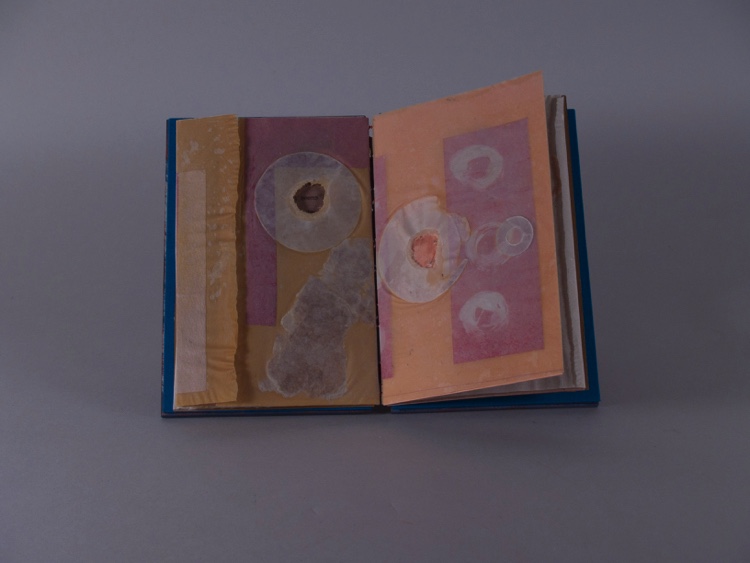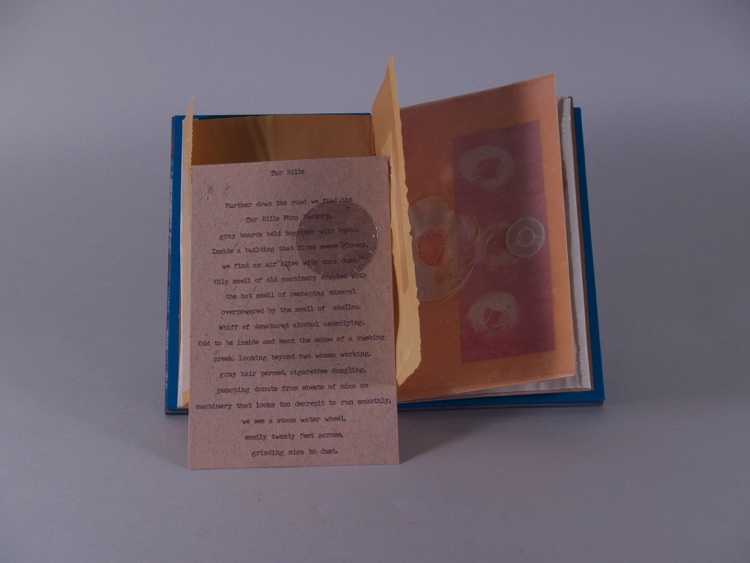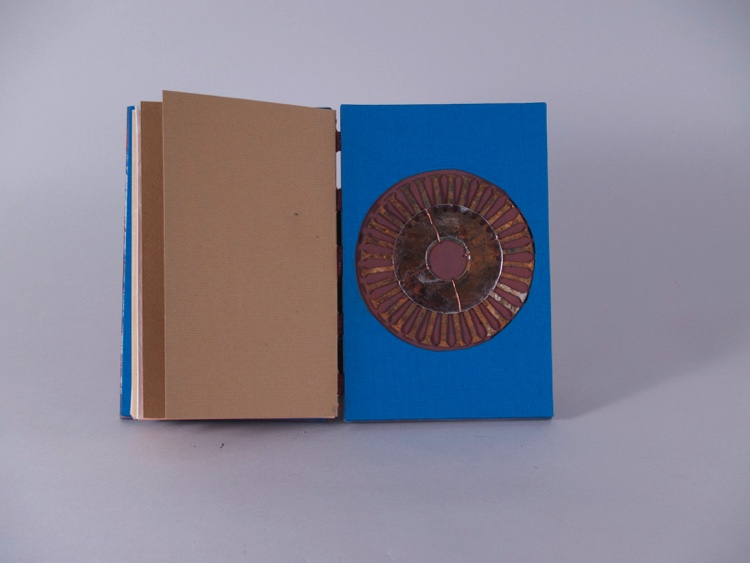Mica
Details
-
© 2009
- Dimensions (in inches): 8 x 5.25 x 1
- Materials:birch plywood, paper (including abaca HMP with inclusions), mica, rusted metal, wire, book cloth, laserprinting, museum board, thread
- Collection of:University of Louisville Fine Arts Library
More
I made this book after spending a day in North Carolina, wading in a stream filled with mica chunks. The pages are sewn on tapes with dimensional wooden covers. Front cover is multi-dimensioned wood with original painting behind mica. Inside back cover has recessed area with metal, wire and mica. Text block is of handmade paper/mixed media in a wrap-around format devised to expose only glimpses of each page until the wrappers are opened. Text is a series of anecdotes around various quests in the southeastern US for the mineral mica. With contributions from Heidi Zednik. The covers were created under the tutelage of Dolph Smith at Arrowmont.
Text:
A near perfect day, wading into a chilly stream.
Enticed by the lure of rumor;
“there is mica in that stretch of stream”.
Big chunks, smaller nuggets of tangible shine.
We gather, then carry them ashore in
pockets overflowing, temporarily marsupial
with pouches fashioned from rolled up shirts.
I rarely look at the photographs from that day,
preferring instead the reminder that comes when
sunshine’s warmth touches my outer ear.
The warmth that is like no other
recalls bearing witness to moments of
trust, connection and lust.
Treasured state mine to cherish
as long as sunshine sparks memory.
Tar Hills
Further down the road we find the
Tar Hills Mica Factory,
gray boards held together with kudzu.
Inside a building that first seems gloomy,
we find an air alive with mica dust.
Oily smell of old machinery coupled with
the hot smell of reshaping mineral
overpowered by the smell of shellac.
Whiff of denatured alcohol underlying.
Odd to be inside and hear the noise of a rushing
creek. Looking beyond two women working,
gray hair permed, cigarettes dangling,
punching donuts from sheets of mica on
machinery that looks too decrepit to run smoothly,
we see a stone water wheel,
easily twenty feet across,
grinding mica to dust.
Buoyed by the promise of potential
raw materials make, we leave with
sheets of mica, clear, speckled, smooth.
Mica washers, thicker and less fine,
a yearning to take away
more than I can afford,
a promise to one another
that we will return.
Later,
I describe to a sculptor who lives
nearby my discomfiture at
being ruled by an acquisitive nature,
so often held in check.
She says ‘I’ve lived here for thirty years,
always sure that the mica factory will shut down.
The mica now comes from India,
the employees are no longer all family.
Still they toil.”
We laugh,
imagining the rotted wood at last falling,
leaving a shell of kudzu,
while the steady work of transforming
imported mineral continues.
A near perfect day, wading into a chilly stream.
Enticed by the lure of rumor;
“there is mica in that stretch of stream”.
Big chunks, smaller nuggets of tangible shine.
We gather, then carry them ashore in
pockets overflowing, temporarily marsupial
with pouches fashioned from rolled up shirts.
I rarely look at the photographs from that day,
preferring instead the reminder that comes when
sunshine’s warmth touches my outer ear.
The warmth that is like no other
recalls bearing witness to moments of
trust, connection and lust.
Treasured state mine to cherish
as long as sunshine sparks memory.
Tar Hills
Further down the road we find the
Tar Hills Mica Factory,
gray boards held together with kudzu.
Inside a building that first seems gloomy,
we find an air alive with mica dust.
Oily smell of old machinery coupled with
the hot smell of reshaping mineral
overpowered by the smell of shellac.
Whiff of denatured alcohol underlying.
Odd to be inside and hear the noise of a rushing
creek. Looking beyond two women working,
gray hair permed, cigarettes dangling,
punching donuts from sheets of mica on
machinery that looks too decrepit to run smoothly,
we see a stone water wheel,
easily twenty feet across,
grinding mica to dust.
Buoyed by the promise of potential
raw materials make, we leave with
sheets of mica, clear, speckled, smooth.
Mica washers, thicker and less fine,
a yearning to take away
more than I can afford,
a promise to one another
that we will return.
Later,
I describe to a sculptor who lives
nearby my discomfiture at
being ruled by an acquisitive nature,
so often held in check.
She says ‘I’ve lived here for thirty years,
always sure that the mica factory will shut down.
The mica now comes from India,
the employees are no longer all family.
Still they toil.”
We laugh,
imagining the rotted wood at last falling,
leaving a shell of kudzu,
while the steady work of transforming
imported mineral continues.
yakyak




